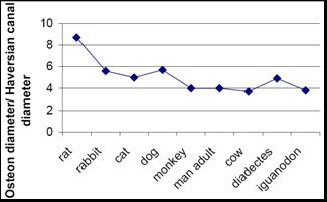Dec 25, 2025
Dec 25, 2025
Ever watched a rat poke his head out of his burrow, looks around, grabs something and in a split second makes a dash to the nearest cover ten metres away. Whereas, a dinosaur or to be more practical a cow walks leisurely on the ground as she grazes, unmindful of the surroundings. Why is the rat so perky and why are the larger animals comparatively sluggish? Has it to do with their sizes?
The great variation of the sizes of bones of animals like rats to dinosaurs has made the experts to ponder about the functional aspects of their skeletons. For example, how does the tiny skeleton of a rat functionally differ from the giant skeleton of a dinosaur? An increase in the bone related ailments in the humans is one of the driving forces behind this type of research. The bio-mechanical experts are trying to find out causes and solutions. Recent studies on the micro-architecture of the bones have brought to light some interesting facts.
Bones are major components of skeletal systems in nearly all vertebrate animals. There are 206 bones in the adult human, which make up 14 percent of total body weight. Animal bones are not mere props that keep animal bodies upright, but play a vital role in the animal’s physiology. For example, Calcium, the essential ingredient for the nerves and muscle cells is stored in bones only. And bone marrow or the soft core of the bone is responsible for producing the red blood cells, certain white cells and blood platelets. Bone is composed of living and nonliving materials and provides a framework to the body and surface for the attachment of the muscles.
Fascinated by the microstructure of bones Sanjay Mishra, an ardent researcher of biomechanics and a graduate in Mechanical Engineering with a doctorate in Orthopedics presently with School of Engineering Systems, Queensland University of Technology, Brisbane, and Melissa Knothe Tate of Departments of Biomedical and Mechanical & Aerospace Engineering, Case Western Reserve University, Cleveland, OH, USA joined hands to develop an allometrical scale for the micro-structure of bones of rat, rabbit, dog, monkey, man, cow and fossil bones of diadectes (an extinct amphibian) and dinosaur. The findings were presented at a recently held seminar in India. The study of bone micro-structure has a strong bearing in the study of bone related problems especially in humans.
Recent researches implicate a cellular basis for many bone diseases in which the tissue health depends on cell viability, which in turn depends on patent transport pathways to deliver nutrients to cells and also to rid them of the waste matter generated around the cells. Studies of these scientists show that the bone micro-architecture is optimized for efficient transport of nutrients to each and every part of the bone.
Osteons or the Haversian system (named after the discoverer Clopton Havers) is like elongated cylinders acting as weight lifting pillars that can withstand high levels of mechanical stress. Hollow canals called the Haversian canals run through the center of the osteon and act as a passageway for blood vessels and nerves. Osteons are found in many of the bones of many mammals, birds, reptiles, and amphibians.
Osteons carry the imprints of their history so that given the right conditions they can be used to "read" the sex, age, health history, motor history and apparently something of the diet of an individual's bone.
The scientists became inquisitive with the thought that larger the structure, for example, a dinosaur, greater would be the size of the osteons and haversian canals! In order to reach a conclusion they tried to develop an empirical relationship between the osteon-haversian canal size and body mass in animal species. The ultimate objective was to find out the influence of osteon and Haversian canal size on efficiency of transport of nutrients to bone cells.
 After making a complex set of calculations the bio-mechanical experts were able to achieve the ratio Osteon : Haversian canal diameter for each of the animal of the aforesaid animal species. It was found that the relationship between Haversian canal diameter and body weight is more positively allometric than that of the osteonal diameter and body weight. The calculations proved that Haversian canal size is more sensitive to animal body weight than Osteen diameter. It was found that smaller the animal larger is the size of the osteon. For example, rat osteons are larger relative to human and cow osteons.
After making a complex set of calculations the bio-mechanical experts were able to achieve the ratio Osteon : Haversian canal diameter for each of the animal of the aforesaid animal species. It was found that the relationship between Haversian canal diameter and body weight is more positively allometric than that of the osteonal diameter and body weight. The calculations proved that Haversian canal size is more sensitive to animal body weight than Osteen diameter. It was found that smaller the animal larger is the size of the osteon. For example, rat osteons are larger relative to human and cow osteons.
It was seen that as the size and the weight of the animal increases there is a relative increase in the diameter of the Haversian canals. However, the ratio of Osteon diameter to Haversian canal diameter amongst the heavier mammals remained a constant from 4 to 6. This ensured efficient transport of nutrients in the bone irrespective of the size.
The net result of the study carried out by Mishra indicated that larger osteon size of rats gave them higher energy efficiency, making them perky and which gives them more chances of survival compared to larger mammals. In other words it gave them an advantage in evolutionary race. Amazing part was that dinosaur bone data had lots of similarities with modern mammals like the human beings.
Hope the human race does not go the dinosaurian way!
Image Haversian Canal Vs Osteon Raio
courtesy Dr. Sanjay Mishra
30-Apr-2006
More by : V. K. Joshi (Bijji)